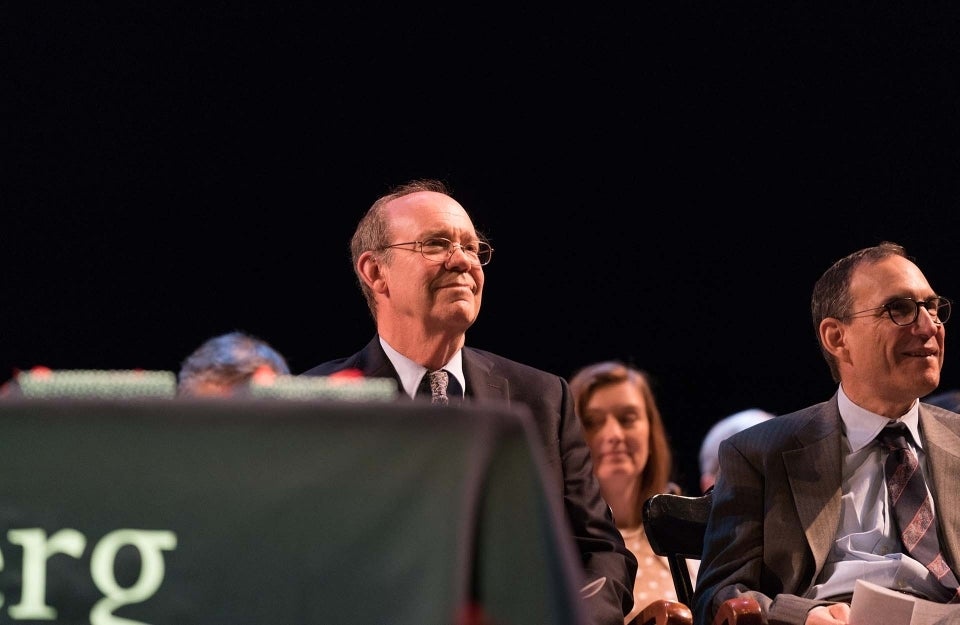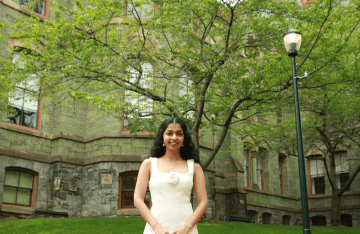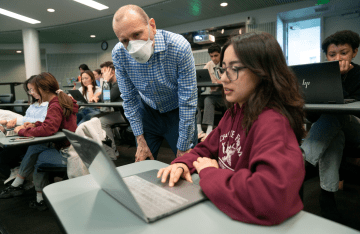Nixon’s China visit, 50 years later
On the 50th anniversary of President Richard Nixon’s visit to China, David Eisenhower discusses the significance of the trip amid the fraying relations between the two nations.

Feb. 21 marks the 50th anniversary of President Richard Nixon’s historic visit to the People’s Republic of China. Heralded as “the week that changed the world,” the trip reestablished America’s relations with mainland China after 25 years of isolation, leading to the opening of that nation to the rest of the world and paving the way to its economic parity with the West.
David Eisenhower, director of the Institute for Public Service at the Annenberg School for Communication shares his thoughts on the significance of the anniversary amid fraying relations between the two nations. Eisenhower, grandson of President Dwight D. Eisenhower and a Nixon son-in-law, offers a perspective into Nixon’s thinking.
Was the opening to China the central objective of the Nixon presidency from Day one?
In 1968, at the height of the Vietnam war, Nixon campaigned on a pledge to ‘end the war and win the peace.’ Americans generally win wars to win the peace, and so the slogan has always lent itself to interpretation and misinterpretation of the Nixon campaign, along with long-standing inaccurate claims that Nixon also campaigned on a ‘secret plan’ for ending the Vietnam War. What he generally meant—and what his audiences understood him to mean by his words—was that he would advance a strategy to ensure that, as the Vietnam war ended, the U.S. would be charting a new path in international affairs that would lead Americans and the world to a new and better place. Likewise, Nixon spoke of a ‘new structure of peace.’
Imminent fulfillment of these pledges was signified dramatically by Nixon’s arrival in Peking, which occurred 50 years ago this week. And Nixon’s 1972 trip to China was prelude to one of the most eventful years in American history.
By the end of 1972, the war was within weeks of ending. The foundations of the ‘structure’ were in place. The U.S. had obtained a shaky peace in Vietnam, forged a strategic partnership with the People’s Republic of China, and entered a period of détente with the USSR. And while these interrelated objectives had been pursued from the start, I would say that the ‘opening’ of China was the lodestar, the central and most important of Nixon’s first-term objectives. It signified that the world was transitioning from the postwar era—the Cold War—towards something different, an international system in which the U.S. would enjoy a pivotal advantage. The trip itself was a dramatic step in furtherance of the new ‘structure of peace.’
Gone, or soon to be gone, were key features of the Cold War: the division of the world into two hostile camps; chronic nuclear tensions; periodic proxy wars. Near term, the China trip formalized China’s final and formal break with the so-called Socialist Commonwealth. Long range, it pointed the way towards a multipolar order and a global economy as well as a major trading partnership between the U.S. and China.
Nixon’s trip in 1972 was world-changing. In my opinion, it stands as one—if not the most important—of a number of defining Cold War era events including the Potsdam conference, Mao’s victory in China, the Eisenhower-Khrushchev summit, the Cuban Missile crisis, and the four Reagan-Gorbachev meetings.
Did Nixon's China success ease U.S. tensions with both the Chinese and the Soviets?
Accentuating the surprise and shock value of the event, Nixon’s China initiative entailed significant risks and required careful preparation. First, it required ongoing efforts to de-escalate Vietnam, looking towards a ‘peace with honor.’ It entailed the risk of defying the Soviets who, by 1969, were engaged in a border war with China which many feared was prelude to a Czechoslovakia-style invasion of the country. Yet Nixon’s companion objective was also to advance detente with the Soviet Union. What many forget is that the Soviets spent the decade of the 1960s attempting to isolate China and to prevent anyone from disrupting their effort to force Mao and the Chinese back into their alliance with the Soviets that China had more or less withdrawn from as early as 1960. There are estimates that by 1969, the Soviets aimed as many nuclear forces at the Chinese as they had aimed at NATO. Ground battles along the Soviet- Chinese frontier began in March and climaxed that August, the month that Nixon decisively shifted the U.S. policy of not meddling in the Sino-Soviet split to one of intervening in it, to bolster China’s autonomy and independence in the face of serious Soviet threats.
Thinking can never become frozen, and leadership must constantly be regenerated.
Nixon’s ongoing effort to attain ‘peace with honor’ in Vietnam was integral to the China opening. If the U.S. was to serve the role as counterweight to the USSR in Asia, the U.S. could not be simultaneously abandoning Southeast Asia in ways unthinkable in Europe or any other theater actually valued by Americans. With the China initiative, the U.S. was committing to a major permanent role in Asia and to Asia’s future. Integral also was Nixon’s conclusion that the risks of confrontation with the Soviets were acceptable, that U.S.-China relations would not wreck but improve U.S.-Soviet relations in time. In his view, the European-oriented Soviets were not bent on war with China, despite the military buildup and menacing polemics, and that the Soviets would stand down in exchange for inducements like détente. It is fair to say that Nixon’s gamble that wading into the Sino-Soviet quarrel would not trigger war but produce lasting results to our advantage was a successful gamble.
What lessons on leadership and diplomacy might be drawn from the visit?
At times, I look back on the 1960s and marvel. Never had America’s problems seemed so grave or incapable of resolution. In the late ’60s, at the height of protests against the Vietnam war and racial disturbances, national policy was one large conundrum. The ability to move beyond the situation is an example of the political adaptability of our Republic that in most fields brings talent to the surface when needed. Meritocracy is a term that describes business, the professions, education, and politics. Looking back to my teen years, I remember the major challenges that faced the country. In the late ’50s and early ’60s, America needed leadership to address civil rights in a dramatic new way, and we found it. When Americans needed ways to end—and redeem—the Vietnam war, Americans found leadership. When faced with the problem of binding up the wounds of the Vietnam war, Americans found people to do that. When the time came to move beyond the postwar altogether, Americans found leaders to move us beyond the Cold War in every way towards a brighter future.
Likewise, thinking can never become frozen, and leadership must constantly be regenerated. As the China initiative recedes into history, it is apparent that the new policy towards China begun in 1972 yielded great benefits, but that the benefits would entail future challenges. So now we find ourselves in a competition with the Chinese.
That some day America would be dealing with a ‘rising China’ was a foreseeable long-range consequence of Nixon’s policy and 1972 trip. After all, a key perception that drove Nixon’s policy was that China was potentially great and that, in principle, throttling China’s inevitable rise was reactionary and wrong. How he came by those views I do not know, but I often heard him speak in glowing terms about China well before his trip to China was announced. Nixon’s view was that China, though devastated by a century of occupation and recent wars, would someday emerge as a major—even dominant—power. He was then more correct than probably he knew.
Nixon’s trip in 1972 was world-changing. In my opinion, it stands as one—if not the most important—of a number of defining Cold War era events.
The China Nixon visited in 1972 was a country that probably resembled the China of the Boxer Rebellion. When my wife and I visited China alone in 1975, it was evident that the country’s infrastructure was in disrepair. Most of its current infrastructure was unbuilt. Yet China in 1975 was inspiring in ways, frightening in ways, poor though not miserable. What we did notice was that the Chinese officials and people we met voiced convincing faith in China’s future greatness. In hindsight, today’s ‘rising China’ can be seen as a product of China’s everlasting embrace of that faith.
Today, as we deal with China’s emergence, the relationship stands on an entirely different basis, not strategic partnership against a common threat but a relationship on the basis of parity, either existing or soon to be. When facing this challenge, we should not underestimate American diplomacy or skill in politics. For many years before and after World War II, Americans had—or cultivated—a reputation for being novices in foreign affairs. The fact is that America has always produced outstanding diplomatic talent; several of our founding era presidents had been secretaries of state. I think that we can rely on our political and diplomatic talent to guide future U.S.-China relations in a positive future direction.
Are there other takeaways?
Another broad point comes to mind. The China opening was a leap, the product of imagination. Einstein is famously quoted to the effect that imagination is as important as knowledge, maybe even more so. Over the years, how many times have I heard Penn professors say that the university’s role is to train but also to encourage initiative and creativity, to inspire and to mold citizens who combine those traits with empathy, tolerance, and compassion? In my lifetime, imaginative leaps abound. The aforementioned civil rights leap in the late 1950s and early 1960s involved a reimagining of our legal and social structure. America’s ‘winning the peace’ in the 1972-1992 period involved an extraordinary leap in world view and strategic thinking. The creation of a post-Cold War globalized economy has involved many leaps.
Remarkable about these leaps is that Americans seem to take leaps for granted, which is also perhaps an achievement of our education and university system. Taking miracles for granted was/has been a major takeaway from my years of researching, writing, and teaching the history of World War II, an undertaking which obliged me to see things from the perspective of other countries engaged in that war. In World War II, the United States built massive fleets and air forces and mobilized 90 divisions—almost 15 million people donned uniforms in a nation of 130 million—and dispatched those forces across two sub-infested oceans to engage in decisive battles against the two most efficient regional military powers of the era. On paper, American intentions were fanciful, utterly beyond the capacity of all other belligerents at the time. Yet aware of their own limitations, our enemies expected such feats of us. We did too, in a matter-of-fact way. As he mobilized the American war effort, FDR made the war effort seem almost routine. Americans today are probably much closer in spirit to that era than is recognized. We don’t think about it much. Characteristically, Americans do not dwell on the past.
Likewise, a takeaway of the China opening is the role of imagination in thought and boldness in execution. Because Americans imagine a better world and because American institutions are accordingly organized to bring one into being, America moves forward. America has consistently produced leaders who are not satisfied with managing things but who anticipate things and who set out to make a difference. At Penn, we are surrounded by such people.
On the 50th anniversary of the long-ago opening to China, we find ourselves fortifying ourselves to face serious economic, social, and international problems. As we define and begin to grapple with these problems, we do so with implicit confidence that solutions are out there, as are the people and resources needed to surmount all challenges. Confidence and belief in the future truly define us as Americans. Confidence and belief in the future are woven into our culture and history—indeed, woven into criticisms of our culture and history. Evidence of such confidence and belief abounds in our recent history and in the China opening of 50 years ago. And so from time to time, it behooves us to acknowledge our faith and belief, traits that lead us to value ability, vision, imagination, and know-how, the capacities that have brought us to this place and move us forward, ever forward.



